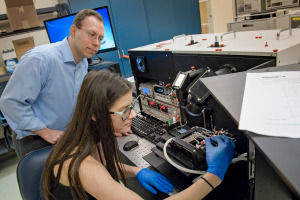Subscriber Benefit
As a subscriber you can listen to articles at work, in the car, or while you work out. Subscribe Now
Microchips—commonly known as semiconductors—power the technologies associated with everyday life. From personal items like computers, phones, cars and smart watches to large-scale assets like the electrical grid and defense systems, microchips are essential.
And the industry is exploding—growing more quickly than the workforce can keep up, leading to bigger shortages in an already limited pool of workers qualified to work in microelectronics.

That’s why Purdue University has announced what it calls a “comprehensive set” of interdisciplinary degrees and credentials in semiconductors and microelectronics.
“The need to restore self-reliance in the semiconductor industry is both an economic priority and a national-security imperative,” Purdue President Mitch Daniels said when the school announced the expanded degrees.
That’s also why Purdue is working with Ivy Tech Community College to develop more microelectronics-related associate degrees and certificate programs as well as attract more high school students into those programs.
Worker shortages, of course, are not new to the manufacturing and technology sectors. And while many industries are struggling to find workers, microchip manufacturers actually have an advantage because much of the production process is automated. However, the high-tech equipment used still requires skilled staff to operate it—and the United States is expected to need another 100,000 engineers and skilled technicians over the next decade.
So, leaders at Purdue and Ivy Tech are confident their combined efforts will help benefit Indiana and the industry as a whole while minimizing microchip production disruptions similar to the one Subaru of Indiana Automotive experienced a year ago.
The Lafayette plant endured a two-week furlough in spring 2021 stemming from a global semiconductor shortage, a problem that sidelined other manufacturers as well.
“Ivy Tech has been looking at microelectronics for quite a while,” said Sue Smith, the school’s vice president for advanced manufacturing, engineering and applied science. “We used to have a program at the college years ago, but demand for those jobs and skill set was so low at that time, we discontinued it.
“Now, we’re trying to resurrect it, but the field is not the same as it once was.”

The Purdue and Ivy Tech efforts dovetail with the Indiana Economic Development Corp.’s launch of a task force—called Accelerating Microelectronics Production & Development—meant to bolster the state’s semiconductor industry. The group, seeded with $2.7 million in state funding, is expected to accelerate and support microelectronics research and innovation in Indiana by securing commercial semiconductor and federal funding opportunities.
“Indiana has a deep advanced manufacturing DNA,” said Indiana Secretary of Commerce Brad Chambers in a statement. “In the coming years, the AMPD task force is focused on supporting this critically important industry in the state.”
Ivy Tech’s Smith is serving on the task force. So is Purdue’s Mark Lundstrom, a professor of electrical and computer engineering who is also helping to lead the efforts at Purdue and the partnership between Purdue and Ivy Tech.
Purdue takes lead role

Purdue has “a long history in semiconductors,” Lundstrom told IBJ. “In fact, this is the 75th anniversary of the transistor at Bell Labs, and we were the ones who supplied the semiconductor they first demonstrated success on.”
Purdue also leads the Scalable Asymmetric Lifecycle Engagement Microelectronics Workforce Development program, a national initiative sponsored by the U.S. Office of the Secretary of Defense to help address the need for engineering graduates who can focus on the development of defense technologies, especially in the area of microelectronics. Peter Bermel, a professor of electrical and computer engineering at Purdue, spearheads that effort.
In addition, Purdue is part of the Semiconductor Research Corp. consortium effort to help define the future technology goals of the microelectronics and advanced packaging technology industry.
Now, it has introduced what it calls its Semiconductor Degrees Program—or PurdueSDP—a series of degrees and credentials that are aimed at “enabling a quick ramp-up of skilled talent.” The offerings include a major and minor for undergraduate students, a master’s degree and post-graduate certificates. The program also includes the associate degree offered by Ivy Tech.
The programs include online and on-campus options and offer what the school calls six-in-one content, with education about chemicals and materials, tools, design, manufacturing, packaging and supply-chain management—all areas that are key to the semiconductor industry.
Through their partnership, Purdue and Ivy Tech will also work toward the enhancement of high school outreach efforts to promote microelectronics as a viable career path as well as the expansion of online training opportunities.
A changing industry
Lundstrom said the United States consumes 47% of all semiconductors produced globally but manufactures only about 12%. The remainder come from China, Japan, South Korea and Taiwan. However, industry experts say there were already weaknesses in the international supply chain before the pandemic. In fact, the 2011 earthquake and tsunami that hit Fukushima, Japan, closed several semiconductor plants, some for many months, as a result of facility damage and rolling power blackouts.
While major U.S. microchip manufacturers such as Intel Corp., NVIDIA Corp. and Texas Instruments Inc. are based in the West and Southwest, there are currently no microelectronics manufacturing facilities in the state of Indiana, according to the IEDC.
“The microelectronics industry began in Silicon Valley and then slowly expanded to Oregon and Texas,” Lundstrom said. “New York state made significant investments in recent years and is now seeing results.
“The Midwest hasn’t historically done much with this and, even though there is national recognition of the need for growth, there’s a notable absence in the Midwest.”
However, California-based Intel recently announced it will invest more than $20 billion in the construction of two microchip factories in Licking County, Ohio, just east of Columbus. The company also said that, at full buildout, total site investment could grow to as much as $100 billion over the next decade.
Construction on the 1,000-acre Ohio Intel project is expected to begin late this year with a targeted production launch in 2025.
Lundstrom said he frequently hears from technology companies that are interested in developing microchip manufacturing plants in various states, including in Indiana.
“But when they’re talking about doing so, one of the first things they mention is the critical need for people to do the work,” he said. “Roughly, we’re talking about the need for 50,000 engineers just over the next few years. That’s more than double what the U.S. is producing right now. And there’s an equally strong need for technicians to run those facilities.”
Smith believes the combined efforts of Purdue and Ivy Tech could help attract semiconductor companies to Indiana and potentially influence students to seek job opportunities in the state after graduation.
“This partnership is really the best of both worlds,” she said. “We have some of the finest research schools in the country, degrees for the workforce and a strong manufacturing presence. If you add all that together, along with the smart manufacturing degree, which we built, and understand that many companies will be incorporating a lot of autonomous systems, Indiana is a pretty attractive place from a workforce perspective.”

Dave Roberts, IEDC’s executive vice president of entrepreneurship and innovation, agrees.
“Due to the global chip shortage and its national-security implications, many semiconductor companies have a renewed interest in reshoring semiconductor manufacturing in the U.S. One of the key challenges in this effort will be the availability of talent,” he said. “Working in semiconductor design and manufacturing does require specific training. By creating a curriculum specific to semiconductors, Purdue and Ivy Tech will be creating a workforce that can be utilized by semiconductor companies on day one.
“By having microelectronics manufacturers located in the state, [students] would be less likely to leave the state upon graduation.”
Studying others
In preparation for its partnership with Purdue, Ivy Tech consulted with representatives from Hudson Valley Community College in New York about the programs they offer in semiconductor technology. Smith said what the school learned from those conversations was essential to planning the Purdue partnership.
“The timeline for bringing an academic program online is about two years, but the good thing about a community college is that we can start with certificates and cross-walk into degrees. I think we could start offering certificates and certifications in about six months,” she said.
“We’ll take a look at what we already have and work with Purdue to develop what we don’t. We’ll also look at other agencies across the country.”
According to Bermel, Purdue has three primary goals relative to microelectronics workforce development and its partnership with Ivy Tech.
“The first goal is to establish students with the foundational knowledge they’ll need to be successful and then, secondly, to provide them with specific skills and abilities that are directly useful in the workplace,” he said. “Third, we want to connect students with potential employers through internships so they can see what it’s like to be in the industry and also establish a mutual fit between the student and a potential employer.”•
Please enable JavaScript to view this content.
